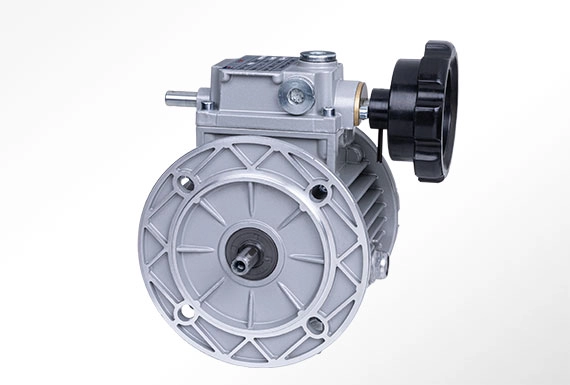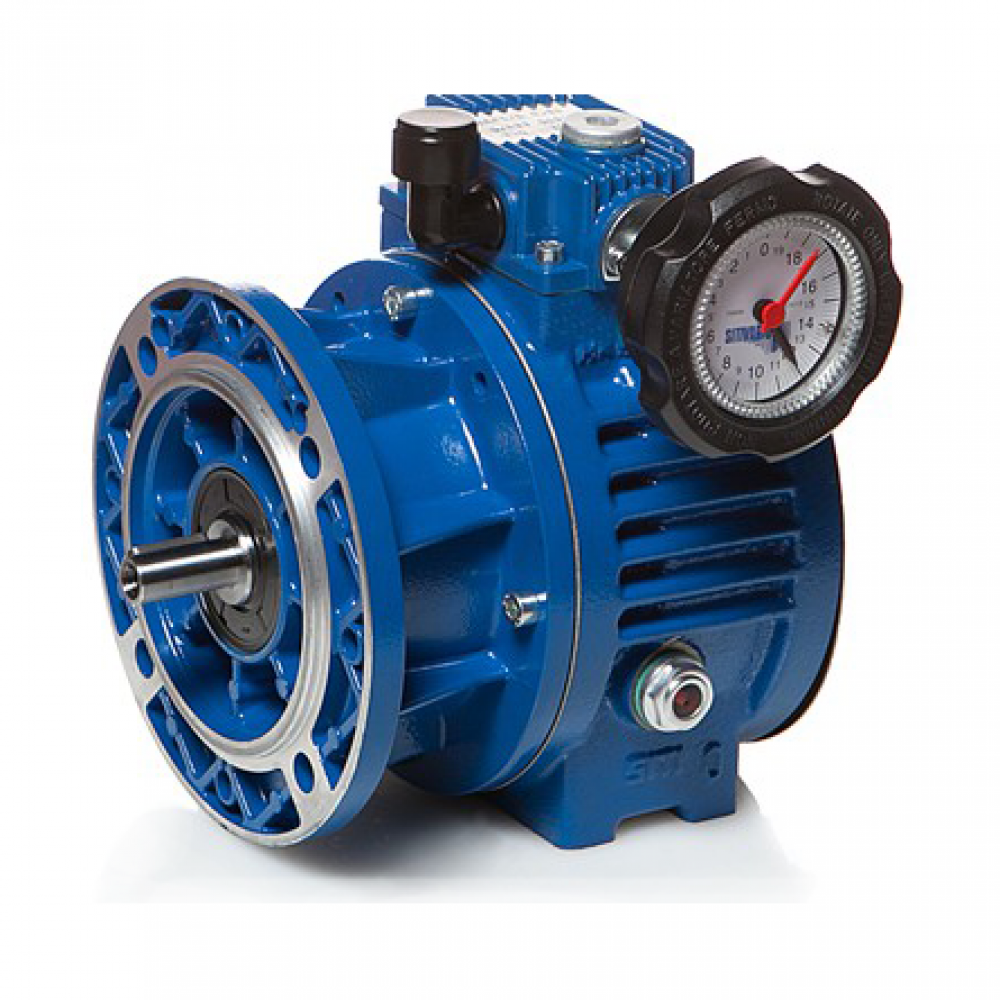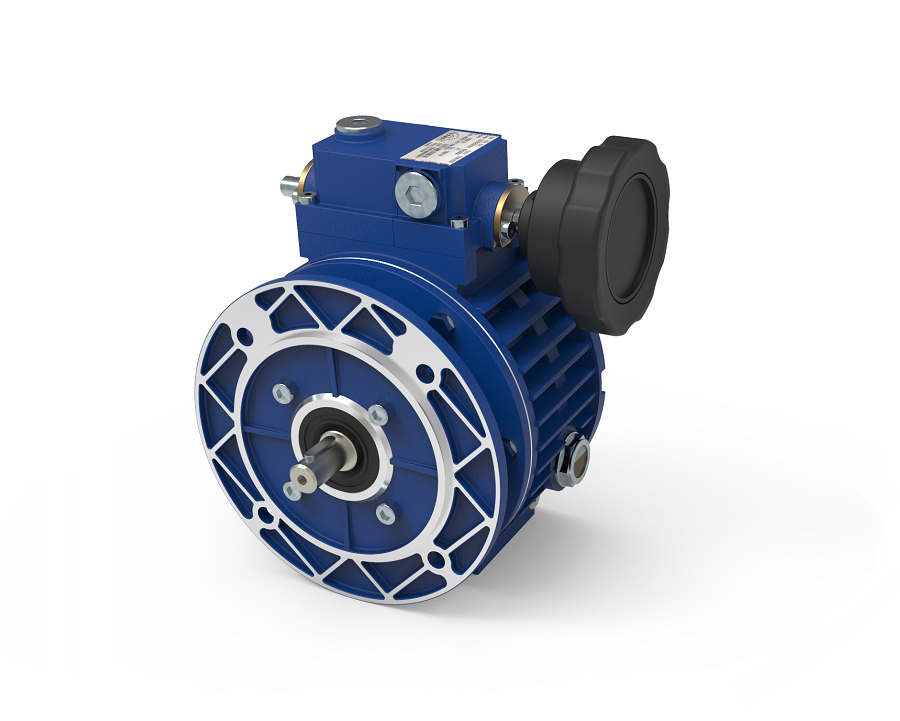Product Description
1) High precision of speed regulating for speed variator,UD gear box: up to 0.5-1 round
2) Large speed-changing range: the speed ratio ranges from 1:1.4 to 1:7 freely
3) High intensity and long serving time
4) Convenient to regulate speed
5) Continuously workable, bidirectional working direction,smooth running,
stable, and quiet
6) Fully sealed and suitable to any environment
7) Compact structure, small size
8) High quality aluminum alloy die-cast, elegant shape, light weight and non-rusting
9) Good adaptability: can be combined with all kinds of reducers to achieve low
stepless speed changing
10) Input power: 0.18-7.5kW
| Power | Model | I | n2(r/min) | M2(NM) |
| 0.18kw | UDL0.18 | 1.6-8.2 | 880-170 | 1.5~3 |
| 0.37kw | UDL0.37 | 1.4-7 | 1000-200 | 3~6 |
| 0.55kw | UDL0.55 | 1.4-7 | 1000-200 | 4~8 |
| 0.75kw | UDL0.75 | 1.4-7 | 1000-200 | 6~12 |
| 1.1kw | UD1.1 | 1.4-7 | 1000-200 | 9~18 |
| 1.5kw | UD1.5 | 1.4-7 | 1000-200 | 12~24 |
| 2.2kw | UD2.2 | 1.4-7 | 1000-200 | 18~36 |
| 3kw | UD3 | 1.4-7 | 1000-200 | 24~48 |
| 4kw | UD4 | 1.4-7 | 1000-200 | 32-64 |
/* January 22, 2571 19:08:37 */!function(){function s(e,r){var a,o={};try{e&&e.split(“,”).forEach(function(e,t){e&&(a=e.match(/(.*?):(.*)$/))&&1
| Layout: | Cycloidal |
|---|---|
| Hardness: | Hardened Tooth Surface |
| Installation: | Vertical Type |
| Customization: |
Available
|
|
|---|
.shipping-cost-tm .tm-status-off{background: none;padding:0;color: #1470cc}
| Shipping Cost:
Estimated freight per unit. |
about shipping cost and estimated delivery time. |
|---|
| Payment Method: |
|
|---|---|
|
Initial Payment Full Payment |
| Currency: | US$ |
|---|
| Return&refunds: | You can apply for a refund up to 30 days after receipt of the products. |
|---|

What role do variators play in enhancing fuel efficiency in vehicles and machinery?
Variators, particularly those used in vehicles and machinery equipped with continuously variable transmissions (CVTs), play a crucial role in enhancing fuel efficiency. By optimizing the power delivery and enabling the engine to operate more efficiently, variators contribute to reducing fuel consumption and improving overall energy efficiency. Here’s a detailed explanation of the role variators play in enhancing fuel efficiency:
1. Continuous Adjustment of Gear Ratio:
Variators in CVTs allow for the continuous adjustment of the gear ratio within their operating range. This means that the engine can operate at the most efficient speed for a given driving condition. By continuously optimizing the gear ratio based on the vehicle’s speed and load, variators enable the engine to stay within its optimal power band, where fuel efficiency is highest. This continuous adjustment ensures that the engine operates at the most efficient RPM (revolutions per minute) for a given speed, resulting in improved fuel efficiency.
2. Elimination of Inefficient Gear Shifts:
Traditional transmissions with discrete gear ratios require frequent gear shifts during acceleration or deceleration. These gear shifts can lead to inefficient engine operation and increased fuel consumption. In contrast, variators in CVTs eliminate the need for gear shifts altogether. The smooth and continuous adjustment of the gear ratio provided by variators ensures that the engine can maintain a consistent and optimal speed, even during changes in vehicle speed. This elimination of inefficient gear shifts helps to improve fuel efficiency by maintaining the engine within its efficient operating range.
3. Precise Engine Control:
Variators enable precise control of the engine speed, allowing for finer adjustments to match the desired vehicle speed. This precise engine control ensures that the engine operates within its most efficient range. Variators continuously optimize the gear ratio based on factors such as throttle input and vehicle speed, ensuring that the engine operates at the optimal RPM for the given driving conditions. By fine-tuning the engine speed, variators help to minimize unnecessary fuel consumption and maximize fuel efficiency.
4. Adaptive Power Delivery:
Modern variators in CVTs often feature advanced control systems that adapt the power delivery to match the driver’s demands and the road conditions. These control systems monitor various parameters, such as throttle input, vehicle speed, and engine load, and adjust the gear ratio accordingly. This adaptive power delivery ensures that the engine operates efficiently in real-time, optimizing fuel consumption. By adjusting the gear ratio based on the specific driving conditions, variators contribute to improved fuel efficiency by delivering the right amount of power for the desired performance.
5. Optimal Use of Engine Torque:
Variators facilitate optimal use of the engine’s torque characteristics. They can be designed to provide a wide range of gear ratios, allowing the engine to operate at the most efficient torque levels for a given speed. By utilizing the available engine torque effectively, variators help to reduce the strain on the engine and improve fuel efficiency. This optimal use of engine torque ensures that the engine doesn’t have to work harder than necessary, resulting in reduced fuel consumption.
6. Energy Recovery and Regeneration:
Some variators in hybrid vehicles or machinery configurations are designed to incorporate energy recovery and regeneration mechanisms. These systems capture and store energy that would otherwise be wasted during deceleration or braking. By converting the kinetic energy into electrical energy and storing it in a battery or capacitor, the energy can be reused to power the vehicle or machinery during acceleration. This energy recovery and regeneration feature helps to improve overall energy efficiency and reduce fuel consumption.
In summary, variators, especially in vehicles and machinery equipped with CVTs, play a crucial role in enhancing fuel efficiency. They achieve this by providing continuous adjustment of the gear ratio, eliminating inefficient gear shifts, enabling precise engine control, facilitating adaptive power delivery, optimizing the use of engine torque, and incorporating energy recovery and regeneration systems. By optimizing power delivery and engine operation, variators contribute to reduced fuel consumption, lower emissions, and improved overall energy efficiency in vehicles and machinery.

Are there aftermarket upgrades available for variators to enhance their functionality?
Yes, there are aftermarket upgrades available for variators that can enhance their functionality and improve the performance of vehicles. These upgrades are designed to optimize power delivery, increase durability, and provide additional features. Here’s a detailed explanation of aftermarket upgrades available for variators:
1. Performance Variator Kits:
Aftermarket performance variator kits are designed to improve the overall performance of the variator. These kits often include upgraded components such as variator pulleys, sliders, and roller weights. The upgraded components are engineered to reduce friction, improve power transfer efficiency, and enhance the variator’s response. Performance variator kits can provide better acceleration, increased top speed, and improved throttle response, resulting in enhanced vehicle performance.
2. Adjustable Variator Pulleys:
Adjustable variator pulleys allow users to fine-tune the gear ratios of the variator. By adjusting the pulley positions, users can customize the variator’s performance to suit their specific needs and preferences. Adjustable variator pulleys can optimize power delivery, improve acceleration, and fine-tune the variator’s behavior for different riding conditions or modifications made to the engine. These pulleys offer increased flexibility and control over the variator’s functionality.
3. High-Performance Variator Belts:
Upgrading to high-performance variator belts can enhance the durability and power transmission capabilities of the variator. High-performance belts are designed to withstand higher temperatures and handle increased power loads. These belts often have advanced materials and construction techniques that improve their strength, flexibility, and resistance to wear. By upgrading to high-performance variator belts, users can improve the reliability and longevity of the variator, especially in high-performance or modified engine setups.
4. Variator Sliders and Roller Weights:
Aftermarket variator sliders and roller weights offer improved performance and adjustability. These components directly impact the variator’s shifting characteristics and the rate at which the gear ratios change. Upgraded sliders and roller weights can provide quicker and smoother shifts, allowing for better acceleration and improved throttle response. Additionally, aftermarket sliders and roller weights come in various weights and profiles, allowing users to fine-tune the variator’s behavior to match their riding style or specific performance requirements.
5. Variator Springs:
Aftermarket variator springs are designed to provide specific tension characteristics that can optimize the variator’s performance. Variator springs affect the rate at which the variator engages and changes gear ratios. Upgrading to aftermarket variator springs can improve launch performance, enhance low-end torque, or provide a more progressive power delivery. By selecting springs with different tension values, riders can customize the variator’s behavior to suit their riding style or desired performance characteristics.
6. Integrated Variator Tuning Modules:
Integrated variator tuning modules, often referred to as ECU or TCU (Engine Control Unit or Transmission Control Unit) tuning modules, are aftermarket devices that allow users to modify the variator’s behavior through electronic control. These modules plug into the vehicle’s electronic system and enable adjustments to various parameters such as shift points, shift speed, and shift firmness. By modifying the variator’s electronic control settings, users can enhance performance, improve throttle response, and customize the transmission behavior to match their preferences.
7. Variator Cooling Systems:
Aftermarket variator cooling systems are designed to improve the cooling efficiency of the variator. These systems often include additional cooling fins, heat sinks, or external coolers that help dissipate heat generated during operation. By improving cooling, aftermarket variator cooling systems can prevent overheating, reduce heat-related performance losses, and increase the overall durability of the variator. These upgrades are particularly beneficial for high-performance applications or when operating in extreme conditions.
In conclusion, aftermarket upgrades for variators offer a range of options to enhance their functionality and improve vehicle performance. Performance variator kits, adjustable variator pulleys, high-performance variator belts, upgraded sliders and roller weights, variator springs, integrated variator tuning modules, and variator cooling systems are some of the available upgrades. These upgrades provide opportunities to optimize power delivery, increase durability, and customize the variator’s behavior according to specific preferences or performance requirements.

Can you describe the benefits of using a variator in terms of efficiency and performance?
Using a variator in various applications can offer significant benefits in terms of efficiency and performance. The ability to continuously adjust the gear ratio and optimize engine RPM contributes to improved fuel economy, smoother power delivery, and enhanced overall performance. Here’s a detailed explanation of the benefits of using a variator:
1. Improved Fuel Efficiency:
A variator allows for precise control of the gear ratio, enabling the engine to operate within its optimal RPM range. By continuously adjusting the gear ratio to match the driving conditions, the engine can maintain an efficient power output. This optimized engine RPM helps to reduce fuel consumption and improve overall fuel efficiency. Variators are particularly beneficial in situations that involve frequent speed changes or stop-and-go traffic, where traditional gear systems may be less efficient.
2. Smoother Power Delivery:
Traditional gear systems have discrete gear ratios, resulting in noticeable gear shifts when changing gears. In contrast, a variator provides stepless gear shifts, allowing for a smooth and seamless power delivery. The continuous adjustment of the gear ratio ensures that the engine operates at the most suitable RPM for the current driving conditions, resulting in a smoother acceleration and a more refined driving experience.
3. Optimal Performance:
A variator enables the engine to operate within its optimal power band. By continuously varying the gear ratio, the variator keeps the engine RPM at an ideal level, maximizing power output and torque delivery. This translates into improved performance, whether it’s for quick acceleration, high-speed cruising, or towing heavy loads. The ability to maintain optimal performance across a wide range of driving conditions is a significant advantage of using a variator.
4. Adaptability to Driving Conditions:
A variator allows for seamless adaptation to different driving conditions. It can adjust the gear ratio based on factors such as vehicle speed, throttle input, and load requirements. This adaptability ensures that the engine operates efficiently and delivers the appropriate power for specific driving situations. Whether it’s accelerating from a standstill, maintaining a constant speed, or climbing steep inclines, the variator can optimize the gear ratio to suit the demands of the moment.
5. Reduced Wear and Tear:
Due to the smooth and continuous power delivery, variators help to reduce wear and tear on various components of the drivetrain. The absence of abrupt gear shifts and the ability to maintain optimal engine RPM contribute to reduced stress on the engine, transmission, and other driveline components. This can result in increased longevity and reliability of the vehicle or machinery.
6. Enhanced Driving Comfort:
The smooth and seamless power delivery provided by a variator contributes to enhanced driving comfort. The absence of gear shifts and the ability to maintain the engine RPM in the optimal range reduce vibrations, noise, and harshness. This leads to a more refined and enjoyable driving experience, particularly in urban driving conditions or during long-distance journeys.
In summary, using a variator in various applications offers benefits in terms of improved fuel efficiency, smoother power delivery, optimal performance, adaptability to driving conditions, reduced wear and tear, and enhanced driving comfort. These advantages make variators a desirable choice for achieving greater efficiency and performance in vehicles and machinery.


editor by CX 2024-03-29